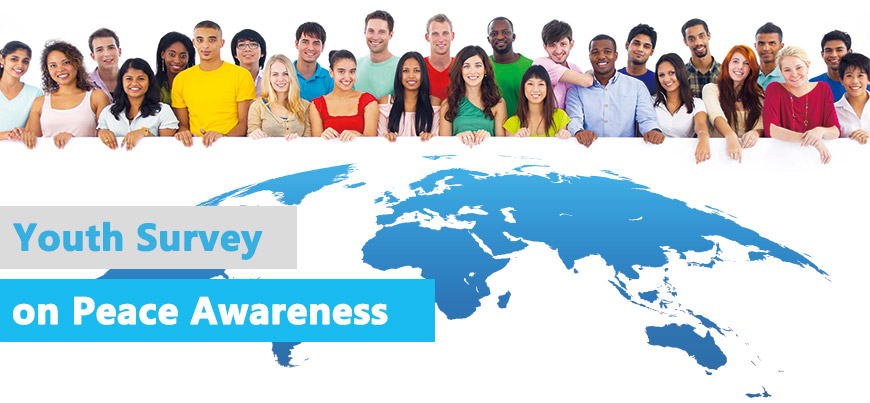
Focusing on the diversity of participants in the International Essay Contest for Young People, which has been held annually for more than 20 years, the Goi Peace Foundation conducted a questionnaire-style survey of young people around the world, asking them about their perceptions of the current state of peace, their awareness of issues related to peace, what they would like to do to contribute to peace, and more.
Following a pilot survey in 2020, we invited all participants (ages 5-25) in the 2021 International Essay Contest for Young People to take this survey on a voluntary basis. We received responses from 6,538 participants in 149 countries (including 239 from Japan), or a quarter of the total participants.
We looked at the survey results from all participants around the world, from participants in Japan and from each of six global regions: Asia/Pacific, North America/Western Europe, Latin America, Eastern Europe/Central Asia, the Middle East, and Africa. For some questions, we also looked at the age of the respondents (children or youth), individual countries, and other data. Analyzing the results from various angles enabled us to uncover some trends described below(see more detailed survey results here)
- Wide Range of Peace Awareness:
When asked what kind of peace is most important when thinking about peace, nearly half of young people answered “Peace on earth, including nature”. In addition, we can infer a tendency to place more emphasis on “Peace of mind” as children get older. - Perceptions of Transition toward World Peace (Past, Present, and Future):
When asked whether the world has become more peaceful than in the past, perceptions differed by region, with more negative responses in Asia/Pacific, the Middle East and Africa.
On the other hand, about 60% of respondents, regardless of region, rated the level of peacefulness in the world today with scores of 40-60 (out of 100), indicating that they feel we are only halfway along on the road to world peace.
When asked about their outlook for the future, a quarter of all respondents said they think the world will become perfectly peaceful during their lifetime, while about half of the youth said they don’t think so. It is particularly noteworthy that young people in the Middle East and Africa, who were mostly pessimistic about the current situation, were more optimistic about the future than those in other regions.
While 60% of Japanese youth said the world was more peaceful than in the past, less than 10% of them thought the world will become perfectly peaceful in the future, which is lower than the rest of the world. - Awareness of Global Issues:
While many of the world’s youth see “Quality of life improved through the advancement of science and technology”, “Better access to education/Quality of education improved” and “Better access to medicine and social welfare” as the greatest improvement, they cited “No discrimination or oppression of human rights”, “No wars or conflicts” and “No poverty or hunger” as top agendas that need to be addressed.
Japanese youth chose the resolution of wars and conflicts as both the greatest improvement and the top agenda going forward, indicating that the idea of peace meaning “no wars or conflicts” is deeply rooted among them. - Perceptions of One’s Own Country:
The percentages of “Yes” and “No” responses to the question “Do you think your country is more peaceful compared to other countries?” were roughly the same throughout the world. Bhutan ranked top in “Yes” responses and Afghanistan in “No” responses, while 90% of Japanese youth said “Yes”.
In the countries where respondents most frequently answered negatively about the level of peace in their country, the issues chosen as most important were “Protecting human rights and freedom”, “Stabilizing the political situation and protecting public safety” and “No wars or conflicts”. - Actions for and Contributions to Peace:
We explored how young people’s awareness of peace is manifested in their actions. It was revealed that 80% of respondents regularly discuss peace with people around them, and that they value peaceful relations, practice kindness toward others and try to solve issues through discussion.
When asked what they need in their life in order to contribute to peace, respondents’ top answers were “Education, space to learn”, “Chance to voice my opinions” and “Connections with like-minded people of my generation”.
The survey results may not fully reflect the opinions of the world’s youth, because all respondents are participants in the International Essay Contest for Young People, and can be regarded as having an interest in peace. It is clear, however, that young people around the world are aware of the various challenges facing their countries and the world, and that each of them is thinking about peace, talking about peace with people around them, and in no small way willing to take action for peace. It is not easy to find hope for the future in today’s society, but the results gave us great hope that young people are seeking a better and more peaceful future and are trying to contribute to peace.
Since its establishment in 1999, the Goi Peace Foundation has developed various educational programs for young people globally, based on the guiding vision Declaration for All Life on Earth, which describes that every one of us shares a common mission and responsibility and has a role to play in the evolution of our planet. In an effort to harness and uplift the world’s youth in playing a leading role in the creation of peace, the Goi Peace Foundation has developed and offered various educational programs for young people globally, including the International Essay Contest for Young People, Education for Sustainable Development (ESD), Earth Kids Space Program, School Lectures by Diplomats, and Entrepreneurship Campus.
The results of this survey will be used as a reference for the Foundation’s future educational programs, and we hope that it will also be a useful resource for policy makers, educators, youth-supporting organizations and others around the world.
